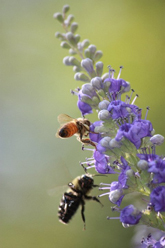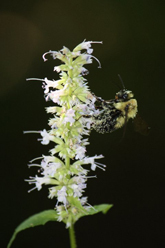Honey Bee and Wild Bee Interaction


Updated April 2, 2012 – www.pollinator.org
The following list of peer reviewed publications has been generated by members of the pollinator LISTSERV. Some of these studies report tests of native bee/honey bee interactions, others provide background and insight into potential interactions. If you have an additional study to add to this list please email info@pollinator.org. We are also in the process of developing a new 2012 NAPPC Task Force that will take on this issue. If you are interested in chairing or participating in this task force please contact Vicki Wojcik, vw@pollinator.org.
Peer Reviewed Publications
- Aizen MA and Feinsinger P (1994) Habitat Fragmentation, Native Insect Pollinators, and Feral Honey Bees in Argentine 'Chaco Serrano'. Ecological Applications 4(2) 378-392
- Badan EI and Vergara CH (2011) Potential negative effects of exotic honey bees on the diversity of native pollinators and yield of highland coffee plantations. Agricultural and Forest Entomology 13:365–372
- Burkle LA and R. Alarcón (2011)The future of plant – pollinator diversity: understanding interaction networks across time, space, and global change. American Journal of Botany 98(3): 528–538.
- Cairns CE, Villanueva-Gutiérrez R, Koptur S, Bray DB (2005) Bee populations, forest disturbance, and africanization in Mexico. Biotropica 37 (4):686-692.
- Dohzono I and Yokoyama J (2010) Impacts of alien bees on native plant-pollinator relationships: A review with special emphasis on plant reproduction. Applied Entomology and Zoology 45:37-47.
- Eickwort GC and Ginsberg HS (1980) Foraging and mating behavior in Apoidea. Ann. Rev. Entomol. 25:421-46
- Ginsberg HS (1981) Historical development of bee foraging patterns in central new york state Psyche 88:337-346
- Ginsburg HS (1983) Foraging ecology of bees in an old field. Ecology 64: 165-175.
- Goulson D (2003) Effects of introduced bees on native ecosystems. Annual Review of Ecology, Evolution, and Systematics 34: 1-26.
- Goulson D, J C Stout, A R Kells Journal of Insect Conservation (2002) Do exotic bumblebees and honeybees compete with native flower-visiting insects in Tasmania ? Journal of Insect Conservation 6(3): 179-189
- Knowles D (1983/4) Flying jewels. Geo 5:46-57
- Kremen C, Williams NM, Thorp RW (2002) Crop pollination from native bees at risk from agricultural intensification. PNAS 99 (26) 16812–16816.
- National Research Council of the National Academies (2006). Status of Pollinators in North America. National Academy Press, Washington, DC.
- Paton DC (1985) Food supply, population structure, and behaviour of New Holland honeyeaters Phylidonyris novaehollandiae in woodlands near Horsham, Victoria. Pages 222-230 in Keats, A, et al, eds. Birds of eucalypt forests and woodlands: ecology, conservation and management. Sydney (Australia): Royal Australian Ornithologists Union and Surrey Beatty and Sons.
- Paton DC (1993) Honeybees in the Australian environment. Bio Science 43: 95-103
- Pearson J FW. (1933) Studies on the ecological relations of bees in the Chicago region. Ecol. Monogr. 3:375-441.
- Potts, SG, JC Biesmeijer, C Kremen, P Neumann, Oliver Schweiger and WE Kunin. (2010) Global pollinator declines: trends, impacts and drivers. Trends in Ecology and Evolution 25 (6) 345-355.
- Pyke GH and Balzer L (1985) The effects of the introduced honey bee (Apis mellifera) on Australian native bees. Occasional paper nr 7. Sydney (Australia): New South Wales National Prks Wildlife Service.
- Roubik DW and Villanueva-Gutiérrez, R (2009) Invasive Africanized honey bee impact on native solitary bees: a pollen resource and trap nest analysis. Biological Journal of the Linnean Society 98: 152-160.
- Roubik DW, Moreno E, Vergara C, Wittmann D (1986) Sporadic food competition with the African honey bee: projected impact on neotropical social bees. Journal of Tropical Ecology 2: 97-111.
- Roubik, DW and H Wolda (2001) Do competing honey bees matter? Dynamics and abundance of native bees before and after honey bee invasion. Popul Ecol 43:53–62
- Sáez A, Sabatino M, and Aizen MA (2012) Interactive Effects of Large- and Small-Scale Sources of Feral Honey-Bees for Sunflower in the Argentine Pampas PLoS One 7(1): e30968.
- Schaffer WM, Jensen DB, Hobbs DE, Gurevitch J, Todd JR and M. Schaffer V (1979) Competition, foraging energetics and the cost of sociality in three species of bees. Ecology 60: 976-987.
- Steffan-Dewenter I and Tscharntke T (2000) Resource Overlap and Possible Competition between Honey Bees and Wild Bees in Central Europe. Oecologia 122(2):288-296
- Stout JC and Morales Cl (2009) Ecological impacts of invasive alien species on bees. Apidologie 40: 388-409.
- Sugden EA and Pyke, GH (1991) Effects of honey bees on colonies of Exoneura asimillima, an Australian native bee. Australian Journal of Ecology 16: 171-181.
- Thomson DM (2004) Competitive interactions between the invasive european honey bee and native bumble bees. Ecology 85(2):458–470
- Thomson DM (2006) Detecting the effects of introduced species: a case study of competition between Apis and Bombus. OIKOS 114: 407-418
- Villanueva-Gutiérrez R, Roubik, DW, Colli-Ucán W(2005) Extinction of Melipona beecheii and traditional beekeeping in the Yucatán peninsula. Bee World 86 (2): 35-41
- Wenner AM, Thorp RW and Barthell JF. Removal of european honey bees from the Santa cruz island ecosystem. Pages 327–335 in Damiani, C.C. and D.K. Garcelon (eds.). 2009. Proceedings of 327 the 7th California Islands Symposium. Institute for Wildlife Studies, Arcata, CA.
- William M. Schaffer WM, DW. Zeh, SL Buchmann, S Kleinhans, MV Schaffer and J Antrim (1983) Competition for Nectar between Introduced Honey Bees and Native North American Bees and Ants Ecology 64(3): 564-577
Reports and other resources
- Morkeski A and Averill AL (2010) Wild Bee Status and Evidence for Pathogen Spillover with Honey Bees CAP Updates: 12: http://www.extension.org/pages/30998/w ild-bee-status-and-evidence-for-pathogen-spillover-with-honey-bees
- Thorp RW, Wenner AM and Barthell JF (1999) Pollen and nectar resource overlap among bees on Santa Cruz Island, click here to view.